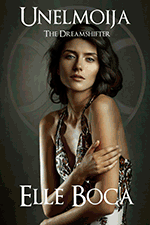Luxury Travel Review

Rayavadee, a contemporary luxury retreat on Thailand’s remote Phranang Peninsula
Article and photos by Josette King

The striking Rayavadee infinity pool overlooked Railay Beach
Some 35 years ago, I fell in love with a place where I had never been. It was a remote paradise concealed among towering jungle-covered limestone cliffs in a virtually unchartered corner of the Andaman Sea, at the tip of the Malay Peninsula; and the secret hideout of arch-villain Scaramanga, The Man with the Golden Gun. As I recently set out to finally visit the eye-popping shores of Southwest Thailand, I reminded myself that a lot had happened during the intervening decades. James Bond has moved on, and the area is now on the list of every savvy beach lover traveling around Southeast Asia. And I have come to place a high value on creature comforts, even as I set out to explore far-flung corners of the planet. However, the high cliffs jutting out of the turquoise sea, with at their base deep, jagged grottoes shaped by millennia of waves and winds, are still achingly beautiful, all the more so for being admired in real time. Best of all, in their midst, there are now a few rare secluded luxury retreats where these unique geological wonders can be enjoyed without having to forsake any contemporary conveniences.
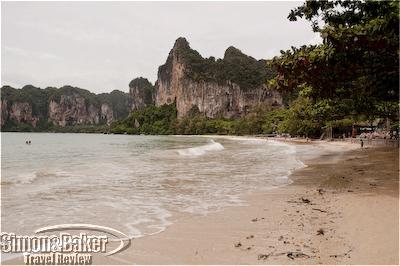
Phranang Beach was renowned for its spectacular limestone cliffs
Rayavadee was just such a place. Set among the soaring cliffs of the Phranang Peninsula at the edge of the Krabi Marine National Park, the five-star property was accessible only by sea. Although the peninsula is actually connected to the mainland, it is effectively cut off from the rest of Krabi by limestone headlands and steep jungle valleys. The short ride from the Krabi pier on Rayavadee’s private speedboat was an exhilarating opportunity to take a first glance at these stunning surroundings. The resort itself, nestled in lush tropical gardens and coconut groves dwarfed by the cliffs, was barely noticeable from the water. Once on shore, however, it revealed itself as a sophisticated retreat of contemporary circular two-story guest pavilions scattered throughout a vast verdant haven.

The bedroom was a colorful contemporary retreat
A network of winding brick-paved footpaths crisscrossed the property, which was also encircled by an unobtrusive road for the quiet electric carts always on hand to ferry me around when I was not in a walking mood. I soon discovered that at Rayavadee all roads led to the beach; two beaches actually, Railay and Phranang, with creamy sands and warm, shallow waters ideal for swimming; both among the most sought-after on the peninsula. As is most often the case in Thailand, these beaches were public, easily accessible to day-visitors via commercial longtail boats, and therefore often busy. However, the property’s boundaries extended to the edge of the beaches, each with a welcoming waterfront restaurant, all the customary beachside amenities and complimentary top quality water sports equipment for the exclusive use the guests.
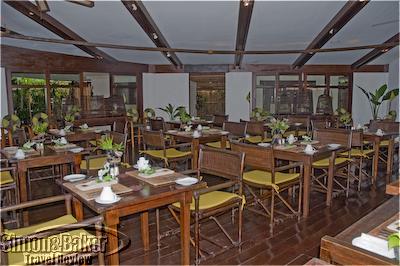
Raya was Rayavadee’s main dining room
The weather was unseasonably stormy at the time of my visit, with occasional rain squalls disturbing the vaunted crystalline waters so that they were not conducive to snorkeling. I often opted for a dip in the pool instead, a vast free-form infinity-edge basin that seemed to lose itself into the sea, while its far end reached out to the nearby cliff. This was indeed the Andaman seashore I had fantasized about all these years ago, with all the luxury I could wish for.
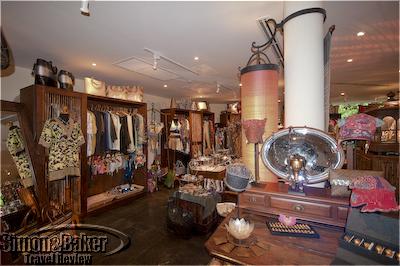
Gift Boutique at Rayavadee
The friendly, polished staff was attentive to my every need and wish. But when I was in the mood for even more pampering, Rayavadee Spa offered an extensive range of massages and salon treatments that combined Thai and international practices that could be adjusted to my specific needs, in a deliciously relaxing contemporary Southeast Asian environment. Then there was the elegant high tea served each afternoon in the main lounge, visibly popular among the guests. Things have indeed changed in this remote corner of the Andaman Sea over the past three decades, but I expect James Bond would approve. Visit the Simon & Baker Travel Review to read more about my visit to Thailand and my stay at Rayavadee and the Phranang Peninsula.
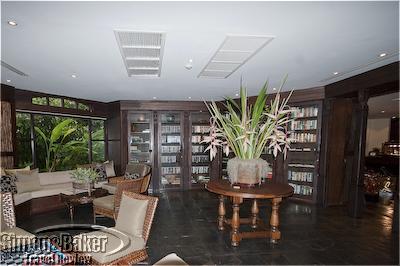
The library
Santhiya Resort and Spa offered timeless Thai romance on Koh Phangan, Thailand
Article and photos by Josette King
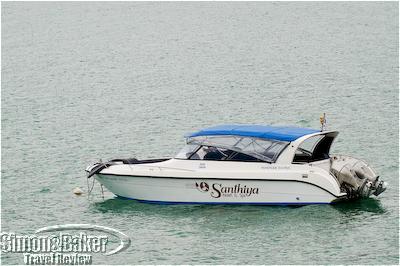
Santhiya’s private speedboat
Koh Phangan, (or simply Phangan in local parlance) is a remote island in the southeastern part of the Gulf of Thailand, 9.5 miles (15 kilometers) north of Koh Samui, its larger and more established sister. Phangan has been popular for several decades among world-trekking backpackers who have been known to congregate monthly by the tens of thousand at the southern tip of the island on Haad Rin beach for the Full Moon Party. For me, however, the island’s magic unfolded farther north, in the secluded northeastern part of the island, where the crescent-shaped bay of Thong Nai Pan is home to the stunning Santhiya Resort and Spa.
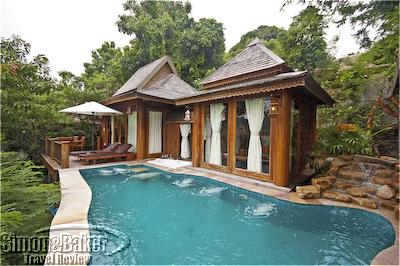
My private plunge pool featured a waterfall
It was a 40 minute ride from Koh Samui on Santhiya’s private speedboat. The latter half of the journey was along Phangan’s pristine coastline of steep hills covered with dense forests rising from the rocky shore. Off and on, strips of creamy sand appeared between the rocks, dotted with a few thatched huts shaded by coconut palm trees. Soon we were approaching a discrete wooden pier at the far edge of Thong Nai Pan, considered one of the loveliest of the island’s beaches. Santhiya rose from the shore, a hillside of exuberant tropical gardens punctuated with peaked roofs characteristic of traditional Thai architecture. Above its gently curving private beach, a tall waterfall splashed into a vast multi-level infinity pool, further enhancing the serenity of the landscape.
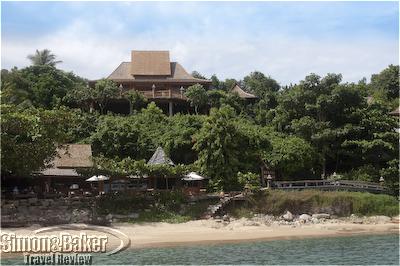
Santhiya’s private beach
King Rama V, who reigned over Thailand for over 40 years in the late 19th and early 20th centuries and is one of the Kingdom’s most revered rulers, is known to have been especially fond of the island, which he visited repeatedly. From the moment the boat prepared to dock to the deep rippling sound of a gong announcing our arrival, I felt I was stepping back into the romance of that bygone era. The property was inspired by the architectural style associated with the monarch, of airy teakwood pavilions under soaring peaked roofs held by tall polished wood pillars, their clean lines enhanced by a profusion of elaborate, lace-like woodcarvings. They also featured inviting terraces with commanding views of the bay; as did my ocean view villa with its private whirlpool plunge pool nestled within the verdant hillside vegetation.
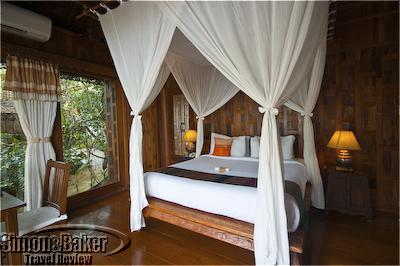
My bed was swathed in white netting
But at Santhiya, timeless elegance and grace were not limited to the surroundings. Every member of the remarkably attentive staff seemed intent on being an ambassador of the vaunted Thai hospitality. And the resort offered a number of opportunities for guests to appreciate traditional lifestyle arts. Thai evenings at Chantara, the property’s main restaurant, were a chance to sample an extensive array of lesser known Thai culinary specialties, and also to listen to and watch regional music and dances performed by Santhiya’s own dance group. I also especially enjoyed the intimate Ayurvana Spa for one of the best combinations of traditional Thai and international treatments I have enjoyed anywhere.
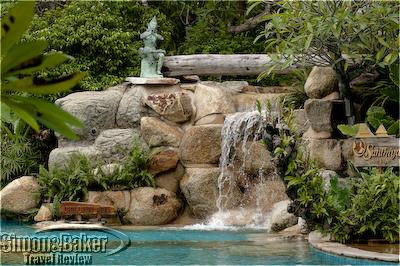
The children’s pool
And as luck would have it, I happened to be at Santhiya on the full moon. The shimmering waters of the Gulf of Siam (as the Gulf of Thailand was once known) were indeed lovely under the pale golden moon, as was the music drifting from the village across the bay; all the more so that I could enjoy it all from the luxurious privacy of my personal terrace. Visit the Simon & Baker Travel Review to read more about Thailand and my stay at the romantic Santhiya Resort and Spa.
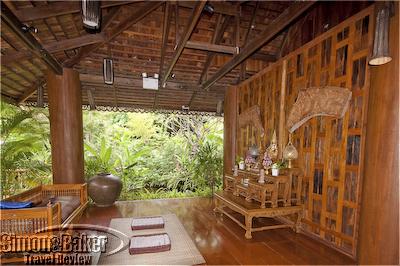
Buddhist shrine
Why I love my Kindle Wi-Fi 6 inches
By Laura Scheiber
Photos by Matthew Harris

I don’t know why I find it so much more enjoyable to read from my Kindle than from a print book, but I do. I resisted. I really did, advocating for the joys of a good ol’ fashioned book. And then everything changed when I got a Kindle as a Christmas present. Perhaps I am still in the honeymoon stage, but I don’t foresee going back to traditional books any time soon.
The Kindle, commonly referred to an e-reader or e-book, offers a portable digital replacement for print books. The screen displays one page at a time and it looks so authentic that I sometimes forget that it is not a paperback. Contrary to print books, there are buttons on the left and right-hand sides of the Kindle, allowing the reader to turn the page at the click of a button.
In general I have found the interface to be very intuitive. The menu button directs you to the Kindle store among other options, while the home button lists your personal library. The Kindle store has over 800,000 books to choose from. I like that you can sample a chapter of a book before purchasing it. This e-reader is set up so that whenever I purchase a new book, it is charged directly out of my Amazon account. My Kindle has the capacity to hold over 3,000 books and it takes approximately 60 seconds to download one book.
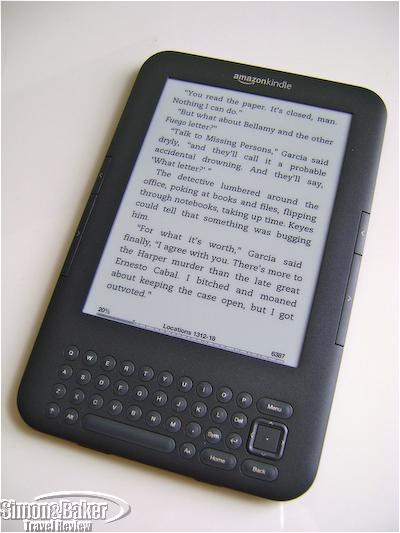
So far I have been impressed with the battery life. I tend to charge my Kindle about every three weeks. Battery life varies depending on the reader because electricity is only needed when turning pages (assuming the wireless feature is turned off). Since the battery life of the Kindle lasts longer with the wireless feature turned off, I only connect to the Web when shopping for new books. It takes three hours to fully charge my Kindle.
For anyone like me who loves to travel, the greatest advantage of this e-reader is having access to a bunch of books without the burden of carrying them.
My Kindle (with leather cover) weighs roughly the same as a 300-page paperback. It fits easily into a carry-on bag or purse. The dimensions measure at 7.5″ x 4.8″ x 0.335” with a 6-inch diagonal. It is about as thick as a pencil and as wide and long as a large postcard. Users who have a travel companion who also has a Kindle, can sync their accounts so that both parties have access to the same books. I foresee my Kindle being particularly useful when traveling to international places where books in English are hard to come by.
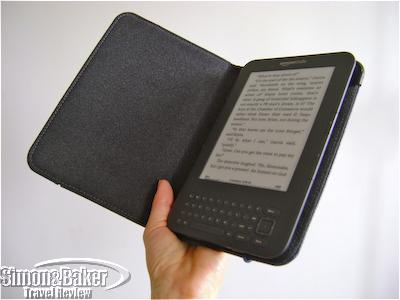
While there is an English dictionary installed for free, there are no translation tools. I hope this is a feature they will add in the future because it would be useful while traveling overseas. One downside of the Kindle when traveling by plane is that all electronic devices must be turned off during take-off and landing, including e-readers.
There are two options of the latest 6-inch Kindle model. The Kindle 3G + Wi-Fi costs $189 and offers wireless Internet coverage in over 100 countries. I opted for the $139 model which does not have this international wireless feature. However, I download books at home prior to traveling and this has worked out very well.
I like the Kindle lighted leather cover, which is sold separately at $59.99. It not only protects my e-reader, but it also has a pullout light in the upper-right hand corner. I love this feature at nighttime because I don’t have to get out of bed to turn off the lights when it is time to sleep.
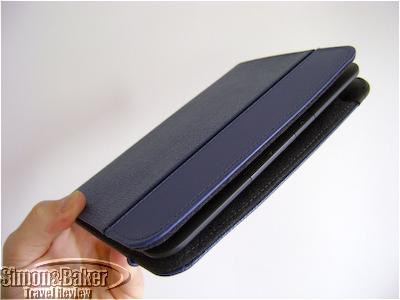
While overall the device does a great job of imitating a print book, I initially found it odd that the Kindle does not display page numbers. Instead it exhibits how far, percentage-wise, I am into the book. This alternative to page numbers has to do with the fact that it is possible to change the font size. As such, it is impossible to list page numbers that consistently reflect the printed version. My only real gripe about the Kindle is that every once in awhile it loses my page number and I have to click through the chapters to find where I had previously stopped reading. Luckily this has only happened twice.
All in all, I love my Kindle Wi-Fi 6” and would absolutely recommend it to others, especially those who love to read while traveling.
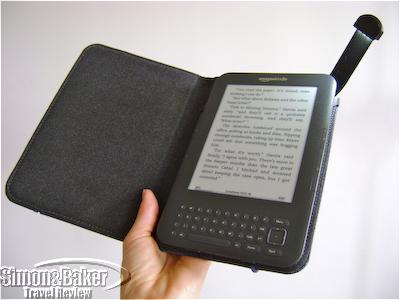
Luberon luxury hotel offered superb hospitality in unique Provence surroundings
Article and photos by Josette King

Gordes is a historic hilltop village of the Luberon
On a drive through the mountainous back roads of Provence, France a few years ago, I stopped at the top of a steep hill, mesmerized by the scenery. On the other side of the precipitous valley, clinging to a sun baked peak overlooking the glorious vistas of the Luberon, was one of the most stunning French villages perchés (hilltop villages) I had ever seen. It started at the very top of the precipice with a rambling fortified castle and church. From there, pale limestone homes and terraced gardens planted with silvery olive trees cascaded all the way to the valley floor. “Gordes,” the road sign announced, its arrow pointing in the opposite direction from the one where I was expected. I only had time to snap a few pictures before driving off with the promise that I would return, someday.

The property is perched above a steep valley
I did return recently, with Gordes as my destination this time, and La Bastide de Gordes and Spa my home. From there, I enjoyed exploring such local jewels as the remote Abbaye de Sénanque, a medieval Cistercian monastery built nine hundred years ago and still active today; and the apricot-colored village of Rousillon, surrounded by the brilliant red quarries of one of the largest ocher deposits in the world, both a mere 15 minutes away. So was the intriguing Village de Bories, a settlement of dry-stone habitations including sheep pens, bread ovens and wine vats dating back to the Bronze Age.
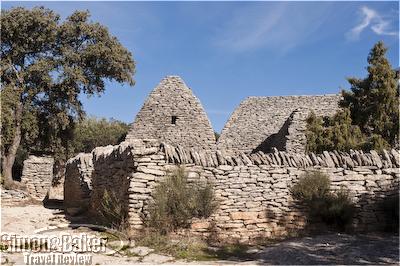
Village de Bories
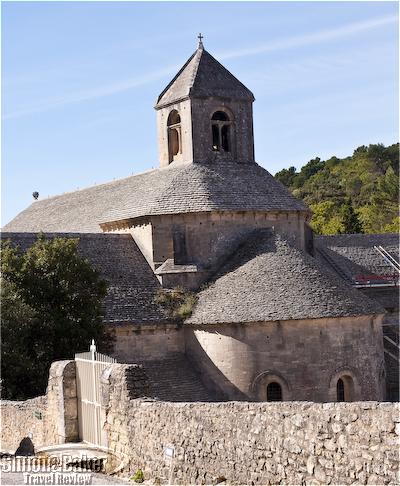
Abbaye de Senanques
But best of all, there was La Bastide de Gordes itself. At the time of my hurried glimpse from the opposite side of the valley, I had mistaken it for a lovely country manor with its cloistered terraces and hanging-garden swimming pool. I loved discovering it now as a luxurious boutique hotel with a warm family-like atmosphere, peerless views of the hills of the Luberon and the Alpilles, a superb restaurant and a wonderful Sisley Spa (one of only three in France). Once again, I left with the promise that I would return, soon I hope. Visit the Simon & Baker Travel Review to read more about my visit to La Bastide de Gordes.
Pierre Herme Paris bakery still worth a special trip for macarons
By Elena del Valle
Photos by Gary Cox
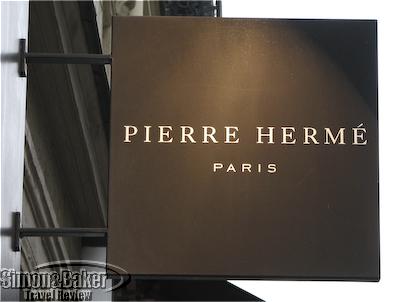
For several years we have been fans of Pierre Hermé macarons, lightly flavored ethereal French pastries (see Pierre Herme Paris bakery for glorious macaron pastries). It had been a while since we had macarons and we were eager to find out if they were as good as we remembered. Soon after arriving in Paris, France we headed straight for the nearest Pierre Hermé shop we found.
It was in the basement of the very crowded Gallerie Lafayette department store not too far from our hotel. It was the first time we visited a satellite of the famous French pastry chef and although not all the macaron flavors were available there were enough to satisfy us until we could make our way to the pastry maker’s boutique in the Latin Quarter near the Church of Saint Sulpice.
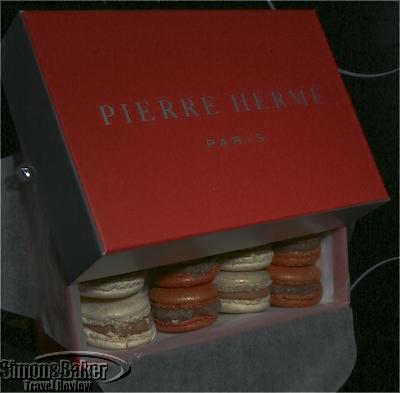
The prepackaged box of specialty foie gras macarons
Time flew away from us and it wasn’t until Christmas Eve morning that we found the time to visit the Latin Quarter Pierre Hermé shop. We made a point of arriving early in the day to avoid the afternoon lines we had seen in prior years during the Christmas and New Year holidays and were surprised to discover a line of customers that spilled outside the shop onto the sidewalk and snaked past the corner. It was snowing and gray but nobody seemed to care as we all stood patiently on the sidewalk waiting our turn in the queue in the freezing cold.
A pleasant young lady from the shop kept the line from bunching up in front on the neighboring store to the bakery. Another lady passed the holiday catalog to patrons in the line and a third young woman held an umbrella in one hand and a tray of chocolates in the other hand while she offered chocolates to patrons waiting in line. The chocolate bite was nice.
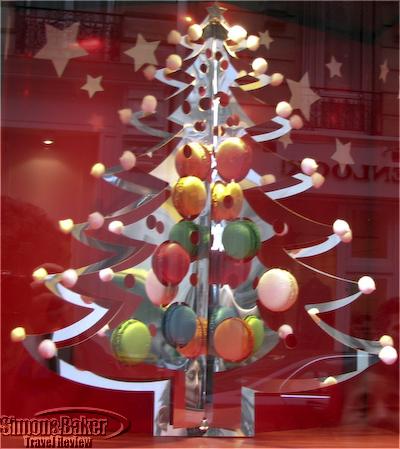
The festive window display featured macarons as ornaments
After a 20 minute wait on the cold and windy sidewalk we entered the small boutique. We were excited to be back and immediately searched the store for macarons. The busy boutique was filled with French, English and Japanese speaking customers and a about a dozen staff members behind the counter. As soon as we approached I saw beautiful seasonal Buches de Noel, pastries and further along, in the display case area nearest the register, the reason for our visit, rows of macaron pastries in a variety of colors and flavors.
No sooner had we joined the line that a young woman offered to help us. We had taken the time while in line outdoors to select our choices from the color catalog and were ready to order.
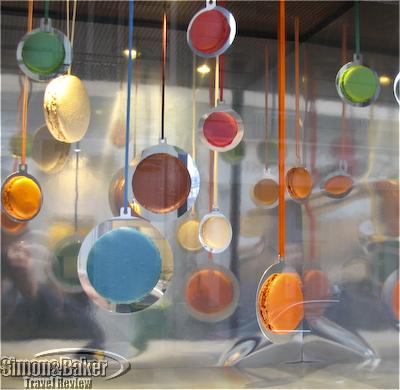
Another window display
With gloved hands she gently picked up the macarons and placed them in our box. After the first selection of Rose macarons she had to stop and wait. It was so crowded behind the counter that she couldn’t reach the macarons to place them in our box. Three of our picks were sold out.
In the past the Macarons D’Excepcion seasonal macarons were available for purchase individually. This year, specialty flavors, seasonal and foie gras, were only available in prepackaged boxes of 16 for 38 euros. One box contained four each of Envie, violette et baies de cassis; Pomme Verte et Angelique de Montagne, pomme verte, angelique de montagne et pommes aciduelees; Fortunella, kumquat, anis etoile, kumquat confit; and Agape, citron et pain d’epices. We knew from past visits that the two foie gras macaron flavors, Chocolate et Foie Gras and Eglantine, Figue et Foie Gras, were favorites and ordered the box containing eight of each.
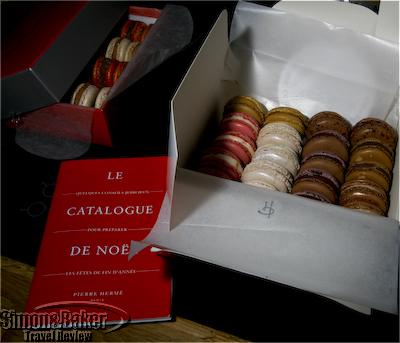
Our selection of macarons
On December 31 we made another trip to the Pierre Hermé store in the morning. Once again there was a line of customers spilling outside the entrance although this line was shorter than the one we had encountered on the previous visit. Staff were managing the queue and handing out chocolates which were divine (it was only possible to purchase them in a variety box rather in single flavors). This time a young lady on seeing our camera while we were outside the store indicated quite firmly to us and the lady in front of us who was photographing the window display that “photographs inside the store are forbidden.” This morning they had no rose macarons, one of my favorites.
As we headed home we collected our thoughts and discovered that although we enjoyed sampling the macarons with a combination of flavors our favorites were the two foie gras varieties and the macarons with a simple combination of flavors, Rose, Truffe Blanche et Noisette (white truffle and hazelnut), and Infinitement Caramel (caramel with salted butter). The best discovery was that we still thoroughly enjoyed the Pierre Hermé macarons. Even after waiting in line in the cold Paris winter our macarons had been satisfying and as good as we remembered them. Vive les Pierre Hermé macarons!
Cambodian Angkor Temples worth the trip to Siem Reap
Article and photos by Elena del Valle
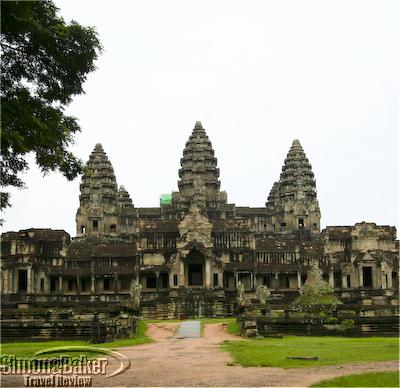
Getting to Siem Reap, Cambodia, the nearest city to the world famous Angkor Temples, from the United States required many hours of travel and a change of airplane in several cities. After spending a few days in Thailand to adjust to the eleven hour time difference and relax a little I headed to Cambodia with some trepidation (after reading about incidents with visas and border guards among other issues). To minimize problems I paid the extra fees to purchase a Cambodian visa online ahead of my trip and requested an airport transfer from the Hotel de la Paix, my Siem Reap hotel. Fortunately my stay was without incident.
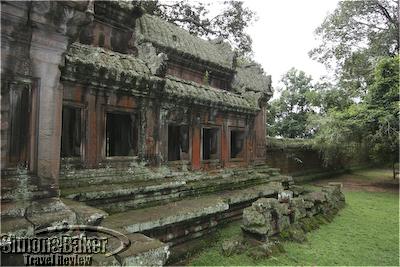
As we were landing I saw miles of emerald green fields and began to feel excited about visiting the area. My flight from Bangkok, Thailand arrived early in Siem Reap so that when I exited the customs area I almost missed my driver. He was English speaking and friendly, making the drive from the airport to central Siem Reap pass by quickly.

When I arrived at the hotel I breathed a sign of relief. Friendly and welcoming faces greeted me as soon as we stopped at the hotel’s porte chochere. I immediately liked the new looking and pretty hotel where I would be staying during my five nights in Cambodia. I knew I would be comfortable and safe. With the help of the hotel staff we planned my outings, filling the early part of my days with visits to the Angkor Temples.
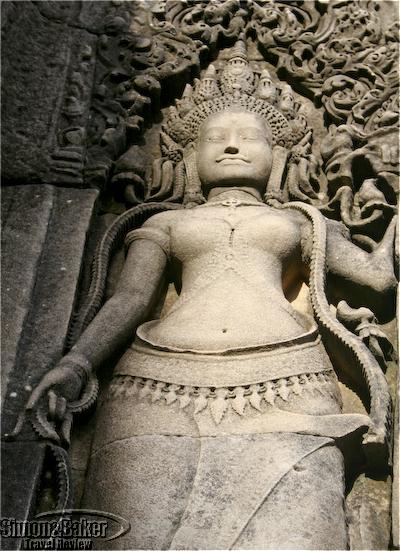
By 6 a.m. most mornings I would be on my way to the nearby temples in the company of Chhai Heaor, a hotel driver, and Pouv Siya, an English speaking official guide and photography lover. Both of the young men were courteous and professional in their demeanor, and service oriented. My guide, a self starter who was learning Spanish online in order to increase his income, was keen to show me the many photography oriented angles for the temples and statues he had discovered.

Pouv Siya, my guide
The reason for the early departure was to avoid the ubiquitous crowds at the temples and catch the temples at the best early morning light for photography. I chose to see fewer temples and spend quality time at each one, stressing my preference for crowd free visits whenever possible. My friendly guide was quite pleased with the news and able to accommodate my request.
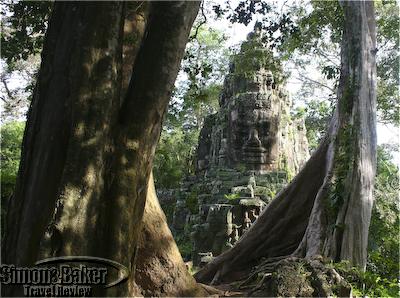
Between the early arrival time and my guide’s familiarity with the temples (as well as the seasonal rains which invariably caught us) we were fortunate to enjoy relative quiet at the temple sites. Although there were always many other visitors at each temple, often they were in another area of the temple or arriving when we were leaving and for the most part we avoided lines, loud visitors and overcrowded areas.
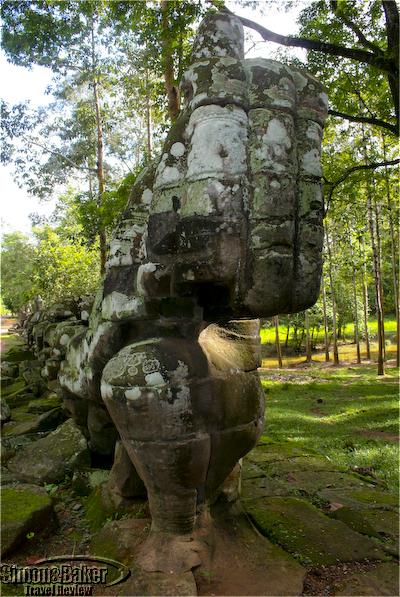
During three outings of several hours each on three different days we visited Angkor Wat, the most famous (and most crowded), Ta Prohm, Bayon, Sras Srang (King’s Pool), Banteay Srey (Lady Temple), Pre Rup (Red Temple). The temples were in a state of disrepair from years of neglect; many of the statues were beheaded, and there was always standing water sometimes inside and outside. Walking required attention as the ground was uneven and at times very slippery, especially just after it rained and it rained daily, sometimes more than once in a day. At several of the temples there were major restoration projects taking place. Although this was a good thing in the long term during our visit it meant that the tall metallic cranes, scaffolding and staff members at work marred the view of the temples.
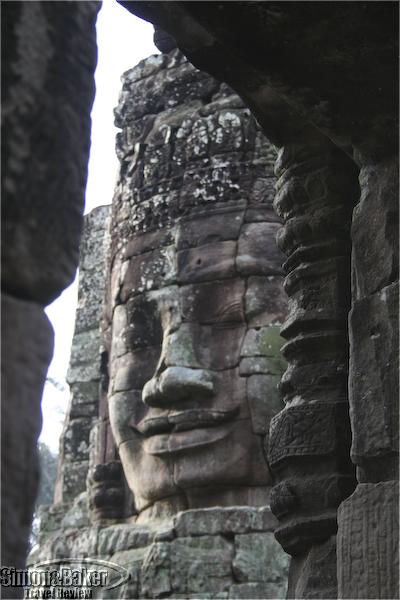
The temples were striking, elegant and memorable. Each temple had its own charm although some were far more popular than others. My favorites were the tree filled Ta Prohm famed for the scenes in one of the Lara Croft movies, and the smaller, less imposing and more intimate Banteay Srey. The Lady Temple was popular in spite of the drive through the countryside that was necessary to reach it. Fortunately, the drive was on a good road where we had a chance to glimpse local homes and monks on their daily rounds. Once at the temple there were clean and modern restrooms and a covered entrance where we took refuge from the rain briefly.
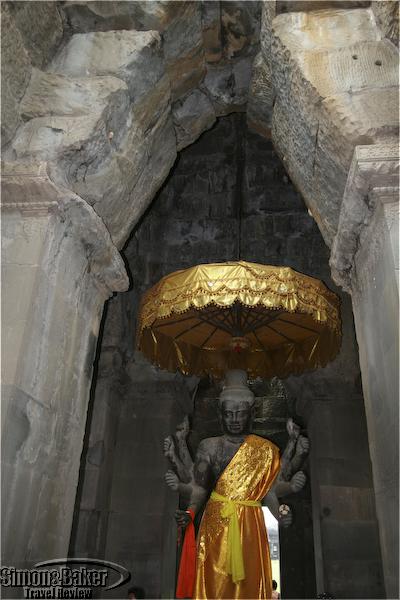
In addition to our early morning arrivals, a little rain gear and some advance planning made it possible for us to miss most crowds and lines. As we walked along the temples, admiring their beautiful artwork I was glad I had made the trip to Cambodia. I look forward to a return trip with my husband to discover more of the temples, the people and the natural treasures of Cambodia.


